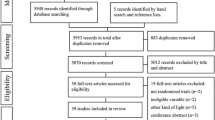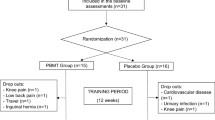Abstract
Muscle fatigue is a process influenced by several mechanisms such as concentration of metabolic substrates, changes in blood flow, and increases in reactive oxygen species that impair contractile muscle function. In this context, photobiomodulation has been investigated for preventing muscle fatigue, with reports of positive effects on muscle performance. This study aimed to investigate the effects of 904-nm LASER photobiomodulation on rectus femoris muscle performance in young women. Eighteen young women participated in a randomized, participant and assessor-blinded crossover trial with placebo control. Active LASER (904 nm, 60 mW, 250 Hz, 3.6 J per diode, total dose of 129.6 J) intervention was applied prior to an isokinetic fatigue protocol consisting of a set of 60 concentric quadricep contractions at a constant dynamometer angular velocity of 180°/s. Compared to placebo, LASER photobiomodulation significantly reduced muscle fatigue across a range of indicators including reduced ratings of perceived exertion (P = 0.0139), and increased electromyographic fatigue index (EFI) (P = 0.005). The isokinetic dynamometer performance analysis demonstrated that LASER photobiomodulation increased peak torque (P = 0.04), time to peak torque (P = 0.042), total work (P = 0.032), average power (P = 0.0007), and average peak torque (P = 0.019) between both experimental conditions. No significant difference was observed for work fatigue index (P = 0.29) or for lactate concentration (P > 0.05). Photobiomodulation at 904 nm was effective in reducing fatigue levels and increasing muscle performance in young active women but had no effect on lactate levels.





Similar content being viewed by others
References
Ivey FM, Roth SM, Ferrell RE, Tracy BL, Lemmer JT, Hurlbut DE, Martel GF, Siegel EL, Fozard JL, Jeffrey Metter E, Fleg JL, Hurley BF (2000) Effects of age, gender, and myostatin genotype on the hypertrophic response to heavy resistance strength training. J Gerontol A Biol Sci Med Sci 55:M641–M648. https://doi.org/10.1093/gerona/55.11.M641
Enoka RM, Stuart DG (1992) Neurobiology of muscle fatigue. J Appl Physiol 72:1631–1648
Allen DG, Lamb GD, Westerblad H (2008) Skeletal muscle fatigue: cellular mechanisms. Physiol Rev 88:287–332. https://doi.org/10.1152/physrev.00015.2007
Cheung K, Hume P, Maxwell L (2003) Delayed onset muscle soreness: treatment strategies and performance factors. Sports Med 33:145–116. https://doi.org/10.2165/00007256-200333020-00005
De Almeida P, Tomazoni SS, Frigo L, de Carvalho Pde T, Vanin AA, Santos LA, Albuquerque-Pontes GM, De Marchi T, Tairova O, Marcos RL, Lopes-Martins RÁ, Leal-Junior EC (2014) What is the best treatment to decrease pro-inflammatory cytokine release in acute skeletal muscle injury induced by trauma in rats: low-level laser therapy, diclofenac, or cryotherapy? Lasers Med Sci 29:653–658. https://doi.org/10.1007/s10103-013-1377-3
Leal Junior EC, Lopes-Martins RA, Vanin AA, Baroni BM, Grosselli D, De Marchi T, Iversen VV, Bjordal JM (2009) Effect of 830 nm low-level laser therapy in exercise-induced skeletal muscle fatigue in humans. Lasers Med Sci 24(3):425–431. https://doi.org/10.1007/s10103-0080592-9
Baroni BM, Leal-Junior ECP, de Marchi T, Lopes AL, Salvador M, Vaz MA (2010) Low level laser therapy before eccentric exercise reduces muscle damage markers in humans. Eur J Appl Physiol 110:789–796. https://doi.org/10.1007/s00421-010-1562-z
Toma RL, Tucci HT, Antunes HK, Pedroni CR, De Oliveira AS, Buck I, Ferreira PD, Vassão PG, Renno AC (2013) Effect of 808 nm low-level laser therapy in exercise-induced skeletal muscle fatigue in elderly women. Lasers Med Sci 28:1375–1382. https://doi.org/10.1007/s10103-012-1246-5
Vassão PG, Toma RL, Antunes HK, Tucci HT, Renno AC (2015) Effects of photobiomodulation on the fatigue level in elderly women: an isokinetic dynamometry evaluation. Lasers Med Sci 31:275–282. https://doi.org/10.1007/s10103-015-1858-7
Karu TI, Pyatibrat LV, Afanasyeva NI (2005) Cellular effects of low power laser therapy can be mediates by nitric oxide. Lasers Surg Med 36:302–314. https://doi.org/10.1002/lsm.20148]
Wong-Riley MT, Liang HL, Eells JT, Chance B, Henry MM, Buchmann E, Kane M, Whelan HT (2005) Photobiomodulation directly benefits primary neurons functionally inactivated by toxins: role of cytochrome c oxidase. J Biol Chem 280:4761–4771. https://doi.org/10.1074/jbc.M409650200
Leal Junior EC, Lopes-Martins RA, Baroni BM, De Marchi T, Taufer D, Manfro DS, Rech M, Danna V, Grosselli D, Generosi RA, Marcos RL, Ramos L, Bjordal JM (2009) Effect of 830 nm low-level laser therapy applied before high-intensity exercises on skeletal muscle recovery in athletes. Lasers Med Sci 24:857–863. https://doi.org/10.1007/s10103-008-0633-4
Dos Reis FA, da Silva BA, Laraia EM, De Melo RM, Silva PH, Leal-Junior EC, de Carvalho Pde T (2014) Effects of pre- or post-exercise low-level laser therapy (830 nm) on skeletal muscle fatigue and biochemical markers of recovery in humans: double-blind placebo-controlled trial. Photomed Laser Surg 32:106–112. https://doi.org/10.1089/pho.2013.3617
Nampo FK, Cavalheri V, Soares FS, Ramos SP, Camargo EA (2016) Low-level phototherapy to improve exercise capacity and muscle performance: a systematic review and meta-analysis. Lasers Med Sci. https://doi.org/10.1007/s10103-016-1977-9
Leal-Junior EC, Vanin AA, Miranda EF, de Carvalho Pde T, Dal Corso S, Bjordal JM (2015) Effect of phototherapy (low-level laser therapy and light-emitting diode therapy) on exercise performance and markers of exercise recovery: a systematic review with meta-analysis. Lasers Med Sci 30(2):925–939
Anders JJ, Wu X (2016) Comparison of light penetration of continuous wave 810 nm and superpulsed 904 nm wavelength light in anesthetized rats. Photomed Laser Surg 34:418–424
Miranda EF, de Oliveira LVF, Antonialli FC, Vanin AA, de Carvalho Pde TC, ECP L-J (2015) Phototherapy with combination of super-pulsed laser and light-emitting diodes is beneficial in improvement of muscular performance (strength and muscular endurance), dyspnea, and fatigue sensation in patients with chronic obstructive pulmonary disease. Lasers Med Sci 30:437–443
Ruiter C, Korte A, Schreven S, Haan A (2010) Leg dominancy in relation to fast isometric torque production and squat jump height. Eur J Appl Physiol 108:247–255. https://doi.org/10.1007/s00421-009-1209-0
Miranda EF, Vanin AA, Tomazoni SS, dos Santos GV, de Paiva PRV, Machado CSM, Monteiro KKDS, Casalechi HL, de Carvalho Pde TC, Leal-Junior ECP (2016) Using pre-exercise photobiomodulation therapy combining super-pulsed lasers and light-emitting diodes to improve performance in progressive cardiopulmonary exercise tests. J Athl Train 51(2):129–135
Toma RL, Tucci HT, Antunes HKM, Pedroni CR, de Oliveira AS, Buck I, Ferreira PD, Vassão PG, Renno ACM (2013) Effect of 808 nm low-level laser therapy in exercise-induced skeletal muscle fatigue in elderly women. Lasers Med Sci 28:1375–1382
Toma RL, Vassão PG, Assis L, Antunes HK, Renno AC (2016) Low level laser therapy associated with a strength training program on muscle performance in elderly women: a randomized double blind control study. Lasers Med Sci. https://doi.org/10.1007/s10103-016-1967-y
Birk TJ, Birk CA (1987) Use of rating of perceived exertion for exercise prescription. Sports Med 4:1–8
Borg G (1998) Borg’s Perceived Exertion and Pain Scales. Human Kinetics, Champaign
Hermens HJ, Freriks B, Disselhorst-Klug C, Rau G (2000) Development of recommendations for SEMG sensors and sensor placement 29 procedures. J Electromyogr Kinesiol 10:361–374. https://doi.org/10.1016/S1050-6411(00)00027-4
Dos Santos MT, Muñoz IS, Nicolau RA, Nogueira DV, Hauck LA, Osório RA, De Paula Júnior AR (2014) Phototherapy effect on the muscular activity of regular physical activity practitioners. Lasers Med Sci 29:1145–1152. https://doi.org/10.1007/s10103-013-1481-4
Baroni BM, Leal Junior EC, Geremia JM, Diefenthaeler F, Vaz MA (2010) Effect of light-emitting diodes therapy (LEDT) on knee extensor muscle fatigue. Photomed Laser Surg 28:653–658. https://doi.org/10.1089/pho.2009.2688
De Brito Vieira WH, Bezerra RM, Queiroz RA, Maciel NF, Parizotto NA, Ferraresi C (2014) Use of low-level laser therapy (808 nm) to muscle fatigue resistance: a randomized double-blind crossover trial. Photomed Laser Surg 32:678–685. https://doi.org/10.1089/pho.2014.3812
Bublitz C, Renno AC, Ramos RS, Assis L, Sellera CA, Trimer R, Borghi-Silva A, Arena R, Guizilini S (2016) Acute effects of low-level laser therapy irradiation on blood lactate and muscle fatigue perception in hospitalized patients with heart failure—a pilot study. Lasers Med Sci. https://doi.org/10.1007/s10103-016-1965-0
Enoka RM, Duchateau J (2016) Translating fatigue to human performance. Med Sci Sports Exerc. https://doi.org/10.1249/MSS.0000000000000929
Leal Junior EC, Lopes-Martins RB, Dalan F, Dalan F, Ferrari M, Sbabo FM, Generosi RA, Baroni BM, Penna SC, Iversen VV, Bjordal JM (2008) Effect of 655-nm low level LASER therapy (LASER) on exercise induced skeletal muscle fatigue in humans. Photomed Laser Surg 26:419–424. https://doi.org/10.1089/pho.2007.2160
Higashi RH, Toma RL, Tucci HT, Pedroni CR, Ferreira PD, Baldini G, Aveiro MC, Borghi-Silva A, de Oliveira AS, Renno AC (2013) Effects of low-level laser therapy on biceps brachialis muscle fatigue in young women. Photomed Laser Surg 31:586–594. https://doi.org/10.1089/pho.2012.3388
Hunter SK (2016) Sex differences in fatigability of dynamic contractions. Exp Physiol 101:250–255. https://doi.org/10.1113/EP085370
Smith AR, Visioli F, Frei B, Hagen TM (2006) Age-related changes in endothelial nitric oxide synthase phosphorylation and nitric oxide dependent vasodilation: evidence for a novel mechanism involving sphingomyelinase and ceramide-activated phosphatase 2A. Aging Cell 5:391–400. https://doi.org/10.1111/j.1474-9726.2006.00232.x
Leal Junior EC, Lopes-Martins RA, De Almeida P, Ramos L, Iversen VV, Bjordal JM (2010) Effect of low-level laser therapy (GaAs 904 nm) in skeletal muscle fatigue and biochemical markers of muscle damage in rats. Eur J Appl Physiol 108(6):1083–1088. https://doi.org/10.1007/s00421-009-1321-1
De Almeida P, Lopes-Martins RÁ, Tomazoni SS, Silva JA Jr, de Carvalho Pde T, Bjordal JM, Leal Junior EC (2011) Low-level laser therapy improves skeletal muscle performance, decreases skeletal muscle damage and modulates mRNA expression of COX-1 and COX-2 in a dose-dependent manner. Photochem Photobiol 87(5):1159–1163. https://doi.org/10.1111/j.1751-1097.2011.00968.x
Leal Junior EC, Lopes-Martins RA, Baroni BM, De Marchi T, Rossi RP, Grosselli D, Generosi RA, De Godoi V, Basso M, Mancalossi JL, Bjordal JM (2009) Comparison between single-diode low-level LASER therapy (LASER) and LED multi-diode (cluster) therapy (LEDT) applications before high-intensity exercise. Photomed Laser Surg 27:617–623. https://doi.org/10.1089/pho.2008.2350
Antonialli FC, De Marchi T, Tomazoni SS, Vanin AA, Dos Santos GV, De Paiva PR, Pinto HD, Miranda EF, de Carvalho Pde TC, Leal-Junior EC (2014) Phototherapy in skeletal muscle performance and recovery after exercise: effect of combination of super-pulsed laser and light-emitting diodes. Lasers Med Sci 29:1967–1976. https://doi.org/10.1007/s10103-014-1611-7
Vanin AA, Miranda EF, Machado CS, de Paiva PR, Albuquerque-Pontes GM, Casalechi HL, de Carvalho Pde TC, Leal-Junior EC (2016) What is the best moment to apply phototherapy when associated to a strength training program? A randomized, double-blinded, placebo-controlled trial: phototherapy in association to strength training. Lasers Med Sci 31:1555–1564. https://doi.org/10.1007/s10103-016-2015-7
Acknowledgments
The authors would like to thank the National Council for Scientific and Technological Development (CNPq) and the Minas Gerais State Agency for Research and Development (FAPEMIG) for their financial support. The authors declared no conflicts of interest existed with respect to the research, authorship, and/or publication of this article.
Author information
Authors and Affiliations
Corresponding author
Ethics declarations
Conflict of interest
The authors declare that they have no conflict of interest.
Ethical approval
All procedures performed in studies involving human participants were in accordance with the ethical standards of the institutional and/or national research committee and with the 1964 Helsinki declaration and its later amendments or comparable ethical standards.
Rights and permissions
About this article
Cite this article
Toma, R.L., Oliveira, M.X., Renno, A.C.M. et al. Photobiomodulation (PBM) therapy at 904 nm mitigates effects of exercise-induced skeletal muscle fatigue in young women. Lasers Med Sci 33, 1197–1205 (2018). https://doi.org/10.1007/s10103-018-2454-4
Received:
Accepted:
Published:
Issue Date:
DOI: https://doi.org/10.1007/s10103-018-2454-4




